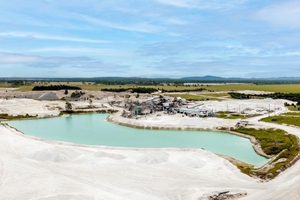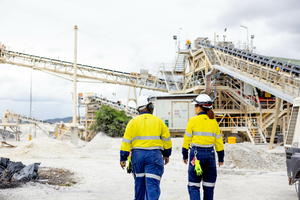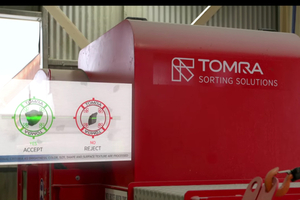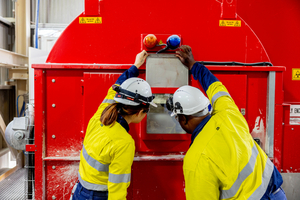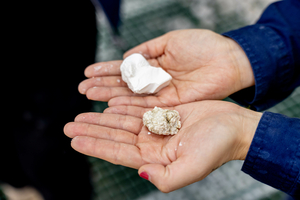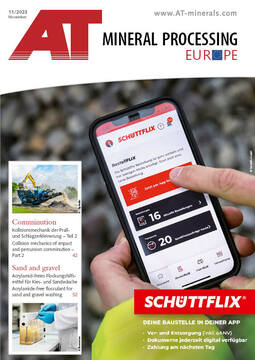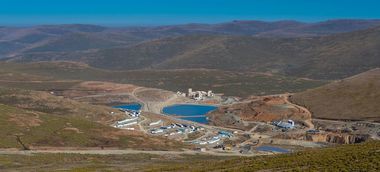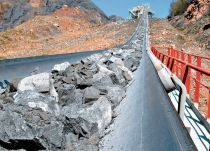TOMRA Mining XRT technology at QMAG’s Kunwarara magnesite deposit
QMAG was an early adopter of sensor-based ore sorting, and is in fact the longest continuous user of this technology in Australia, having installed its first Ultrasort laser machine in 1994 and a second one a few years later. The ore was fed through a Dense Media Separation (DMS) system, using drum and Cyclone separators, then the Ultrasort sorters removed the sandstone, gravel and dark coloured dolomite from the product.
After over 22 years in operation, the Ultrasort sorters were becoming antiquated and could no longer be supported. “It came to a point where the Ultrasort sorter was removing the dolomite, but the background lime was still quite high, and this was not giving us the best opportunity to create the product that was required by the Parkhurst processing plant,” explains Josh Dawson, Production Superintendent at the QMAG mine. A new solution was needed, and TOMRA suggested its X-Ray Transmission technology.
TOMRA’s XRT sorter halves heavy media usage and extends the life of the deposit
In 2016, a TOMRA XRT sorter was installed as a stand-alone plant on site. “It was a trial that management at the time got very excited about: they could see that this could be the future moving forward,” says Josh Dawson. “It was a success story: we could now process very high calcium content material that we couldn’t do as effectively with the DMS or laser sorting equipment. This gave the ability to produce much lower calcium content magnesite grades suitable for our customers,” adds Alex Padya, Process Engineer.
In view of these results, in 2018 the XRT machine was moved into the sorting plant, where it replaced the remaining Ultrasort that had reached the end of its life, and the DMS drum was decommissioned: “With this decision, we halved our heavy media usage in that part of the circuit and went to a standalone XRT circuit,” says Josh Dawson. As a result, the XRT circuit has delivered significant savings in energy and water usage, and increased the plant’s efficiency.
The TOMRA XRT sorter has exceeded expectations, as Josh Dawson explains: “When we originally made the business case, we thought that it would be used to upgrade the lower quality magnesite ores to produce grades suitable for agricultural purposes, while the heavy media cyclones would make our lower silica materials for other applications. However, by collaborating with TOMRA to optimize the performance of the XRT unit, we can now turn agricultural products into much higher grades required by the Parkhurst processing plant.” TOMRA’s XRT sorter has also extended the life of QMAG’s deposit: “We were at the point where we thought that a lot of our ore body wasn’t going to achieve the grade for some of our lower end products. The TOMRA XRT machine proved that we could now mine those deposits and turn them into useful product for the higher end applications”
Agility, simple operation, easy maintenance
“It’s a very easy machine to operate,” explains Alex Padya. “We have three specific sorting programmes depending on the feed material to get a very intensive, mild or slight rejection rate. Once set up, you virtually leave the sorter to do its job.” Josh Dawson adds: “Having programmes pre-set in the machine instead of using the slidescale takes out human error and makes it all very seamless for us.”
Switching programmes is very simple and quick, which makes the TOMRA XRT sorter exceptionally agile in responding to the frequent variations in the material that comes from the ore body at QMAG’s deposit. If the material coming from a particular part of the deposit doesn’t yield the desired results, TOMRA’s team is always ready and quick to make the necessary adjustments to the programmes.
XRT sorting: opportunities for future
The results were so positive that QMAG updated its plant replacing the 6-year-old unit with a new TOMRA XRT sorter. In addition, a second unit has now been added to further increase production capacity through this process route. QMAG is currently considering the possibilities that ores sorting technology can open up for the future.
“We see that the technology is improving to the point where we’re starting to consider that XRT can potentially do what the heavy media can do, and in some respects better.” affirms Josh Dawson. Alex Padya agrees: “Over the last few years we have done a lot of runs without going through the cyclone, going straight to the XRT sorter, and ending up with the final product.” Josh Dawson concludes: “We are looking as a business for our next stages, potentially moving away from the traditional heavy media, and I see a future of a lot more ore sorting technology at QMAG. The technology is moving fast and TOMRA is a leader in this technology. We are excited to see what technology TOMRA develops next.”

